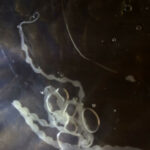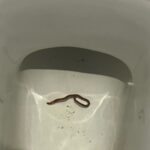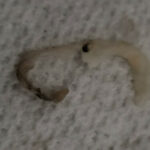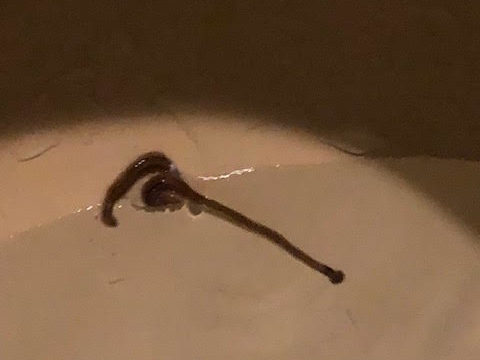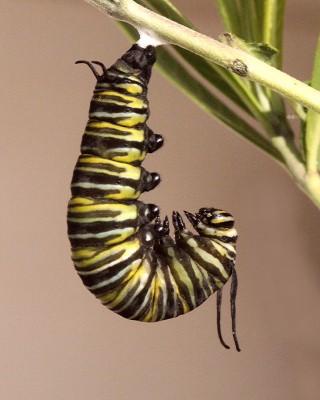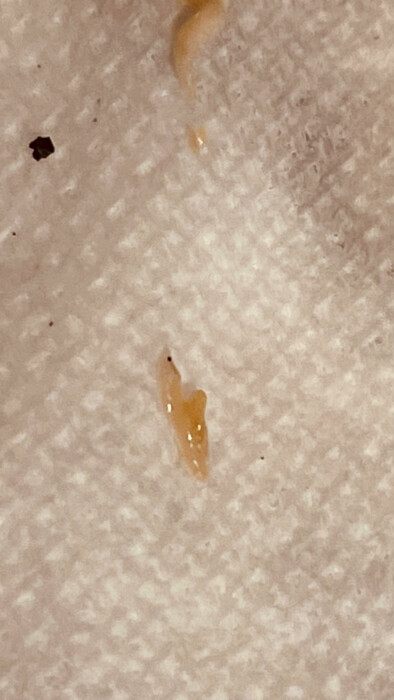
“I found these in the aerator of my bathroom sink”, writes Clifton in his submission regarding the gooey-looking creature pictured below. “The pictures are after they were not noticed and the aerator was placed in boiling water: due to a boiling advisory by the city. So the color may be different than when they were alive. Someone else found the same ones in their faucet and they claimed they were tapeworm larvae.” To start with, we want to thank Clifton for the excellent photo. Usually, such a photo, which is as crisp as this one, helps us identify the organisms we are looking at. In this case, it just shows us in greater detail that we have no idea what we are looking at.
The organism has no discernible head, appendages, segmentation, markings, orifices, or other features. On top of that, Clifton does state that the creature was essentially boiled alive, which definitely could have changed, if not mangled, its features. It is also possible –and we apologize for the imagery– that these are bits of a larger organism that fell off when it got boiled. Alternatively, these are not organisms at all, but just organic debris in the pipes that have come up through the faucet. In any case, we will not be able to provide an identification of this creature. On top of that, Clifton mentions the possibility, or theory, that these could be tapeworm larvae. He does not mention if he has other cause to believe, like if he were experiencing symptoms of some kind, but in any case, we are not able to identify tapeworms because they are parasites.
And why is that? Parasites such as tapeworms infect humans and cause health issues, and since we are not medical professionals, we are neither qualified nor legally able to identify parasites, as doing so would be tantamount to diagnosing a health issue. If Clifton begins to suspect for other reasons that these might be tapeworm larvae, or wants to get himself checked just in case, we recommend consulting a medical parasitologist, as they specialize in this area. He could likewise consult his primary care doctor, but in our experience, we’ve heard from so many readers who have been turned away from their primary care doctors when they come to them with problems like this: the reason being that primary care doctors typically do not receive training in parasitology.
If Clifton wants to find a medical parasitologist in his area, he can do one or more of the following:
1) Search for a medical parasitologist in his area using this directory of medical parasitology consultants: https://www.astmh.org/for-astmh-members/clinical-consultants-directory.
2) Search for a local parasitologist by doing a Google search for “medical parasitologist (name of the closest big city)” or “tropical medicine specialist (name of the closest big city)”.
3) Get in touch with Dr. Omar Amin at the Parasitology Center at https://www.parasitetesting.com.
We should note that Dr. Amin is available for online consultation, so our reader does not need to be in the vicinity of his physical offices to get help!
In conclusion, we are unable to identify the creatures photographed by Clifton. This is mainly because the creatures are completely devoid of identifying characteristics, which may be due to the fact that they were found after being boiled, but it is also due to Clifton’s suspicion that these might be parasites. Despite not providing an identification, we hope that we are able to help to some extent, we wish Clifton the very best.
All About Worms is always free, always reader-supported. Your tips via CashApp, Venmo, or Paypal are appreciated! Receipts will come from ISIPP Publishing.
You might also find these guys interesting!




